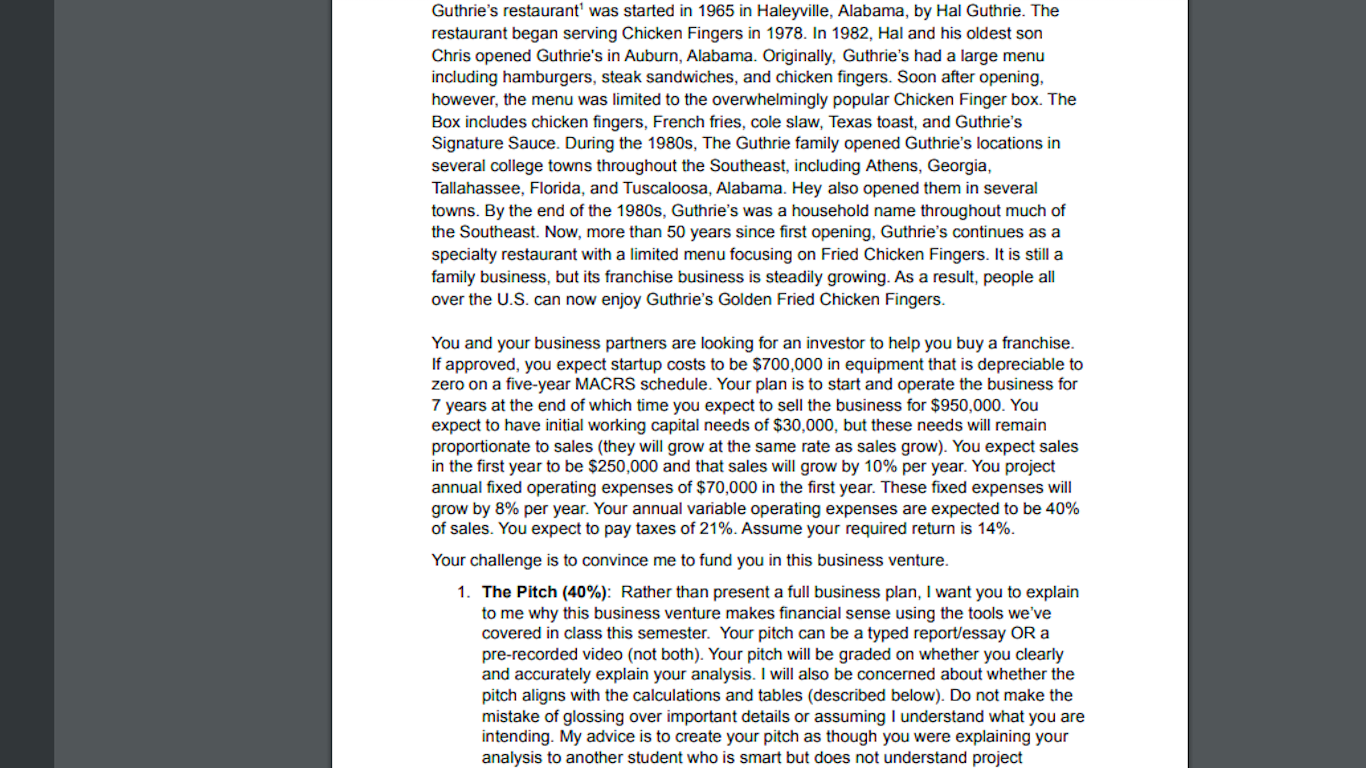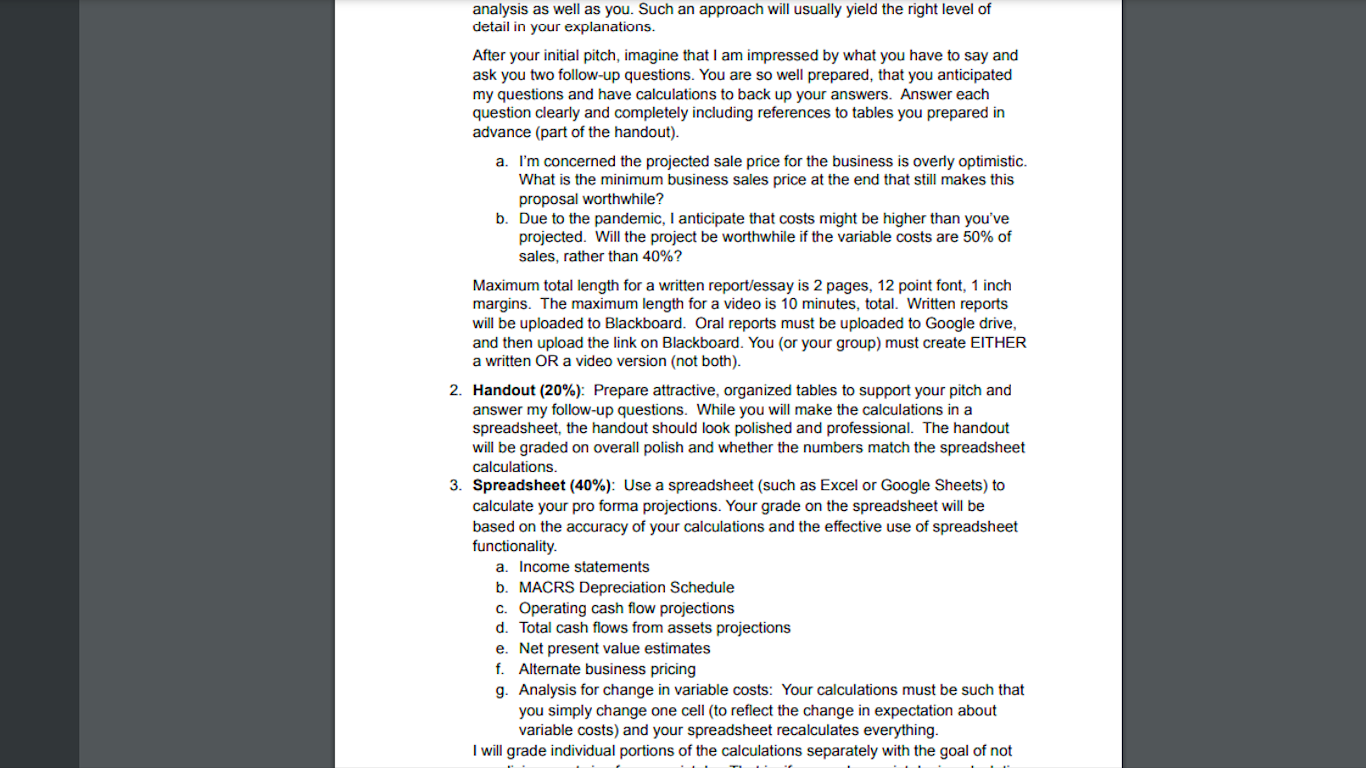

Guthrie's restaurant' was started in 1965 in Haleyville, Alabama, by Hal Guthrie. The restaurant began serving Chicken Fingers in 1978. In 1982, Hal and his oldest son Chris opened Guthrie's in Auburn, Alabama. Originally, Guthrie's had a large menu including hamburgers, steak sandwiches, and chicken fingers. Soon after opening, however, the menu was limited to the overwhelmingly popular Chicken Finger box. The Box includes chicken fingers, French fries, cole slaw, Texas toast, and Guthrie's Signature Sauce. During the 1980s, The Guthrie family opened Guthrie's locations in several college towns throughout the Southeast, including Athens, Georgia, Tallahassee, Florida, and Tuscaloosa, Alabama. Hey also opened them in several towns. By the end of the 1980s, Guthrie's was a household name throughout much of the Southeast. Now, more than 50 years since first opening, Guthrie's continues as a specialty restaurant with a limited menu focusing on Fried Chicken Fingers. It is still a family business, but its franchise business is steadily growing. As a result, people all over the U.S. can now enjoy Guthrie's Golden Fried Chicken Fingers. You and your business partners are looking for an investor to help you buy a franchise. If approved, you expect startup costs to be $700,000 in equipment that is depreciable to zero on a five-year MACRS schedule. Your plan is to start and operate the business for 7 years at the end of which time you expect to sell the business for $950,000. You expect to have initial working capital needs of $30,000, but these needs will remain proportionate to sales (they will grow at the same rate as sales grow). You expect sales in the first year to be $250,000 and that sales will grow by 10% per year. You project annual fixed operating expenses of $70,000 in the first year. These fixed expenses will grow by 8% per year. Your annual variable operating expenses are expected to be 40% of sales. You expect to pay taxes of 21%. Assume your required return is 14%. Your challenge is to convince me to fund you in this business venture. 1. The Pitch (40%): Rather than present a full business plan, I want you to explain to me why this business venture makes financial sense using the tools we've covered in class this semester. Your pitch can be a typed report/essay OR a pre-recorded video (not both). Your pitch will be graded on whether you clearly and accurately explain your analysis. I will also be concerned about whether the pitch aligns with the calculations and tables (described below). Do not make the mistake of glossing over important details or assuming I understand what you are intending. My advice is to create your pitch as though you were explaining your analysis to another student who is smart but does not understand project analysis as well as you. Such an approach will usually yield the right level of detail in your explanations. After your initial pitch, imagine that I am impressed by what you have to say and ask you two follow-up questions. You are so well prepared, that you anticipated my questions and have calculations to back up your answers. Answer each question clearly and completely including references to tables you prepared in advance (part of the handout). a. I'm concerned the projected sale price for the business is overly optimistic. What is the minimum business sales price at the end that still makes this proposal worthwhile? b. Due to the pandemic, I anticipate that costs might be higher than you've projected. Will the project be worthwhile if the variable costs are 50% of sales, rather than 40%? Maximum total length for a written report/essay is 2 pages, 12 point font, 1 inch margins. The maximum length for a video is 10 minutes, total. Written reports will be uploaded to Blackboard. Oral reports must be uploaded to Google drive, and then upload the link on Blackboard. You (or your group) must create EITHER a written OR a video version (not both). 2. Handout (20%): Prepare attractive, organized tables to support your pitch and answer my follow-up questions. While you will make the calculations in a spreadsheet, the handout should look polished and professional. The handout will be graded on overall polish and whether the numbers match the spreadsheet calculations. 3. Spreadsheet (40%): Use a spreadsheet (such as Excel or Google Sheets) to calculate your pro forma projections. Your grade on the spreadsheet will be based on the accuracy of your calculations and the effective use of spreadsheet functionality. a. Income statements b. MACRS Depreciation Schedule c. Operating cash flow projections d. Total cash flows from assets projections e. Net present value estimates f. Alternate business pricing g. Analysis for change in variable costs: Your calculations must be such that you simply change one cell (to reflect the change in expectation about variable costs) and your spreadsheet recalculates everything. I will grade individual portions of the calculations separately with the goal of not Guthrie's restaurant' was started in 1965 in Haleyville, Alabama, by Hal Guthrie. The restaurant began serving Chicken Fingers in 1978. In 1982, Hal and his oldest son Chris opened Guthrie's in Auburn, Alabama. Originally, Guthrie's had a large menu including hamburgers, steak sandwiches, and chicken fingers. Soon after opening, however, the menu was limited to the overwhelmingly popular Chicken Finger box. The Box includes chicken fingers, French fries, cole slaw, Texas toast, and Guthrie's Signature Sauce. During the 1980s, The Guthrie family opened Guthrie's locations in several college towns throughout the Southeast, including Athens, Georgia, Tallahassee, Florida, and Tuscaloosa, Alabama. Hey also opened them in several towns. By the end of the 1980s, Guthrie's was a household name throughout much of the Southeast. Now, more than 50 years since first opening, Guthrie's continues as a specialty restaurant with a limited menu focusing on Fried Chicken Fingers. It is still a family business, but its franchise business is steadily growing. As a result, people all over the U.S. can now enjoy Guthrie's Golden Fried Chicken Fingers. You and your business partners are looking for an investor to help you buy a franchise. If approved, you expect startup costs to be $700,000 in equipment that is depreciable to zero on a five-year MACRS schedule. Your plan is to start and operate the business for 7 years at the end of which time you expect to sell the business for $950,000. You expect to have initial working capital needs of $30,000, but these needs will remain proportionate to sales (they will grow at the same rate as sales grow). You expect sales in the first year to be $250,000 and that sales will grow by 10% per year. You project annual fixed operating expenses of $70,000 in the first year. These fixed expenses will grow by 8% per year. Your annual variable operating expenses are expected to be 40% of sales. You expect to pay taxes of 21%. Assume your required return is 14%. Your challenge is to convince me to fund you in this business venture. 1. The Pitch (40%): Rather than present a full business plan, I want you to explain to me why this business venture makes financial sense using the tools we've covered in class this semester. Your pitch can be a typed report/essay OR a pre-recorded video (not both). Your pitch will be graded on whether you clearly and accurately explain your analysis. I will also be concerned about whether the pitch aligns with the calculations and tables (described below). Do not make the mistake of glossing over important details or assuming I understand what you are intending. My advice is to create your pitch as though you were explaining your analysis to another student who is smart but does not understand project analysis as well as you. Such an approach will usually yield the right level of detail in your explanations. After your initial pitch, imagine that I am impressed by what you have to say and ask you two follow-up questions. You are so well prepared, that you anticipated my questions and have calculations to back up your answers. Answer each question clearly and completely including references to tables you prepared in advance (part of the handout). a. I'm concerned the projected sale price for the business is overly optimistic. What is the minimum business sales price at the end that still makes this proposal worthwhile? b. Due to the pandemic, I anticipate that costs might be higher than you've projected. Will the project be worthwhile if the variable costs are 50% of sales, rather than 40%? Maximum total length for a written report/essay is 2 pages, 12 point font, 1 inch margins. The maximum length for a video is 10 minutes, total. Written reports will be uploaded to Blackboard. Oral reports must be uploaded to Google drive, and then upload the link on Blackboard. You (or your group) must create EITHER a written OR a video version (not both). 2. Handout (20%): Prepare attractive, organized tables to support your pitch and answer my follow-up questions. While you will make the calculations in a spreadsheet, the handout should look polished and professional. The handout will be graded on overall polish and whether the numbers match the spreadsheet calculations. 3. Spreadsheet (40%): Use a spreadsheet (such as Excel or Google Sheets) to calculate your pro forma projections. Your grade on the spreadsheet will be based on the accuracy of your calculations and the effective use of spreadsheet functionality. a. Income statements b. MACRS Depreciation Schedule c. Operating cash flow projections d. Total cash flows from assets projections e. Net present value estimates f. Alternate business pricing g. Analysis for change in variable costs: Your calculations must be such that you simply change one cell (to reflect the change in expectation about variable costs) and your spreadsheet recalculates everything. I will grade individual portions of the calculations separately with the goal of not








